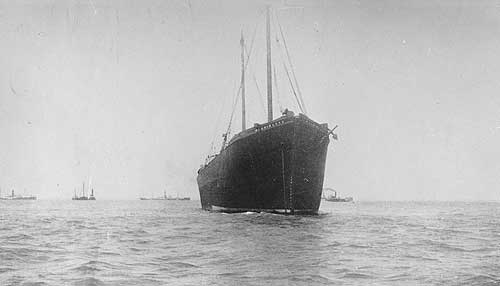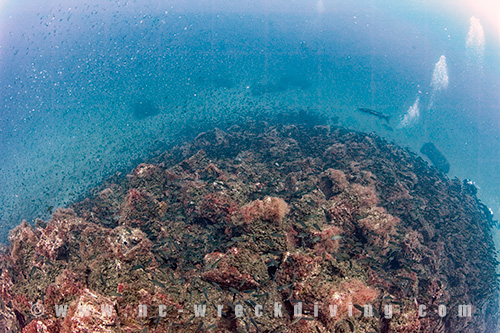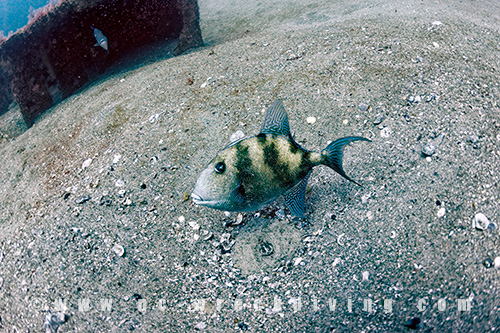
Home Port: unknown
 |
|
| SHIP NOTES: | |
| Name: "BOX WRECK" |
Type: tow schooner barge (?) |
| Built: unknown | Owner: unknown Home Port: unknown |
| Size (ft.): 175-200 ft. (?) x 30-35 ft. (?) | Tonnage: unknown |
| Propulsion: none; demasted sailing ship | |
| Date Sunk: 1930's (?) | Cause: foundered |
| Location: Cape Lookout, NC | GPS: N34° 11.665'/W76° 22.564' |
| SHIP HISTORY: (33) | |||
| As demands of shipping and industry turned from sail and windpower, a lot of cargo carrying capacity was locked up in the holds of old and not-so-old sailing vessels. The economics of shipping dictated that it was often more cost-effective (due to size of crew, speed, predicted schedules, risk, etc) to take this capacity and tow it by steam power than to let them travel, fully-crewed under the capriciousness of wind power. These were called schooner barges. The idea appears to have originated in the 1870s in the Great Lakes. These sailing ships often had their masts cut down or shortened and had the capability of limited self-propulsion in cases of emergency. The ships were strung together, loaded with cargo —very often coal— in a line, behind a tug or other steam ship. When added to the tow line, an additional schooner barge did little to impact the fuel consumption of its mechanically powered "engine", but it added significantly to how much cargo could be delivered. In many ways, it was like a sea-going train, with the steamship serving as the engine, and the schooner barges serving as the floating railroad cars. The system proved so effective, that in later years, schooner barges were even built new, rather than simply an obsolete hand-me-down. Thousands of these "barges" existed through-out the US. Their use declined by World War II as coal was replaced by even more efficient fuel-oil. The Box Wreck appears to one such ship. Its "named" identity is unknown and will probably remain so as there are literally 100's of these type of wrecks up and down the east coast of the U.S. From artifacts collected from the wreck, it appears to have sunk in the 1930-1935 era. |
|||
 |
|||
|
Washington, typical schooner barge, used by the US Navy during WWI (6)
|
|||
 |
|||
|
San Joaquin, another schooner barge, used by the US Navy during WWI (6)
|
|||
|
|
|||
 |
|||
|
The twin anchors still in their hawse pipes — the bulk of the wreck in the distance
|
|||
 |
|||
|
The twin anchors — another view — windlass in the distance
|
|||
 |
|||
|
The shape of the wreck site viewed from above
|
|||
| DIVING NOTES: | |||
| Diving Depths: 100 - 110 ft | |||
| Current: slight to strong | |||
| Visibility: 40 ft to 100 ft. | |||
| Summer Temperature: hi 70s to lo 80s | |||
| Points of Interest: two anchors, anchor windlass, numberus boxes and cargo; | |||
| Fish/Animal Life: heaven for small to medium size tropical fish life; lionfish very common; | |||
| Description: The Box Wreck is continuous and relative small, and thus is easy to circumnavigate in one dive. The bow end is where the concentration of machinery is, most notably, the two anchors, anchor windless and other mechanical parts. This is also the most likely point to anchor on the wreck as it is the most solid part to tie-in. The few times I have been on the wreck, the current was not a problem and the visibility was over 50 feet. I suspect, given the wrecksite's relatively far distance from Cape Look Shoals, those good conditions may be close to the norm. Conditions are probably best on an east, south or southeast wind which tends to push the clear Gulf Stream water onto the wreck. The wreck shape is like a football or watermelon cut in half, laying long-ways, with the flat side down. The wreck rises along its spine in two separate "humps" — a lower one towards the bow and a taller one a midships. The highest of these rises comes up to 25+ feet. The entire wreck made up of stacks and stacks of encrusted boxes and other cargo. The nooks and crannies of these stacked boxes make ideals homes for small fish, invertebrates, crabs and octopus. Schools of small baitfish often cover areas of the wreck. Because of its relatively shallow depth, ease of diving, and abundance of fishlife, underwater photographers should love this wreck. The Box Wreck in many respects is a larger, and IMHO, a bit more interesting twin of the Catherine Monohan, a wreck that sits just south of Cape Hatteras. One is made of stacks of encrusted boxes, while the other is made of stacks of encrusted cement bags. |
|||
|
Video tour of the Box Wreck
|
|||
 |
|||
|
Typical Box Wreck topology - stacks of "boxes" in the shape of a half a watermelon laying on the ocean floor
|
|||
 |
|||
|
There quite a number of triggerfish and triggerfish nests on the Box wreck.
|
|||
 |
|||
|
Theres a pile of railroad ties on the port side of the wreck...assuming anchored at the end with the anchors and windlass
|
|||
 |
|||
|
Wood planks and timbers still remain
|
|||
 |
|||
|
Your probable anchor point on the windlass
|
|||
| Unless specifically noted, all photos, text and content Copyright © Paul M. Hudy | |||
|
|

 |